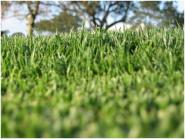Source:
igK Tech. Dpt.
11 November 2013
Fertilizing: Necessary plant food
Turfgrass, like any other plant, needs nutrient that are vital for its growth and development
 La política de fertilización debe adaptarse al propósito de la superficie
La política de fertilización debe adaptarse al propósito de la superficie
There are 17 essential elements (with different concentrations in the plant). The three most important are hydrogen, carbon and oxygen, natural non-mineral nutrients obtained from the air (CO2) and water (H2O), and which are metabolized by photosynthesis. The other 14 nutrients have a mineral origin and mainly come from the soil and are absorbed through the roots. Some, such as iron, are pulverized as sulphate or complex salts (chelates) that are incorporated through the leaves (foliar absorption).
Fertilizing programs are mainly based on on three macro-nutrients, which are the ones the plant needs in greater proportion: Nitrogen (mainly), Phosphorus and Potassium. The programs differ because they take into account factors such as: the necessary quality level (a baseball field is not the same as a recreational garden), the potential growth rate, environmental factors (location, runoff, etc.), soil analysis and water and budgetary contraints.
As regards nitrogen needs, the most demanding turfgrass species, such as a green with Agrostis stolonifera, for example, requires 20 to 30 grams of Nitrogen per m2 annually. On the other hand, an ornamental garden, may have much lower requirements, on the order of 5 to 10 grams of Nitrogen per m2 annually.
The use and efficiency when applying different types of fertilizers need to be optimum, if only for cost reasons. For this, we base ourselves on three factors that also have a sustainable character from the environmental standpoint:
1) Spoonfeeding: A fertilizing program of the highest quality (for example, the greens on a golf course) may include up to 20 applications per year, which does not imply fertilizing more (the needs are known beforehand and exceeding them is harmful to the turfgrass quality), but rather is done in small doses, making the plant take the fullest advantage of it, and likewise minimizing leaching or losing the nutrients that are carried away by water through the soil profile, thus avoiding the contamination of subterranean waters.
2) Fertilizer types: There is an increasing availability and use of a larger number of slow release and controlled release fertilizers that gradually release nutrients depending on the temperature, humidity and, in the case of some of the more recent ones, by osmosis. These, like the foliar fertilizers (liquids that are sprayed and quickly absorbed by the leaves) also minimize the effects of leaching and contamination of underground waters.
3) Clippings from mowing: When possible (especially in ornamental gardens) the mowing clippings should be left on the soil surface. Clippings are rich in all types of nutrients, and by reincorporating them into the soil with some of the plant exudates means less fertilizer is used.